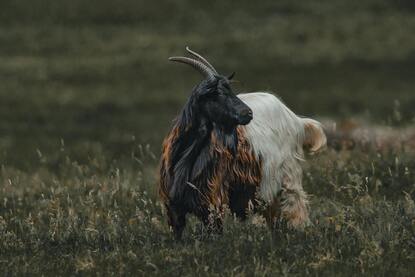|
Do you know — or remember — the Norwegian story, Three Billy Goats Gruff? It’s a cautionary tale that warns against the temptation and consequence of greed. It tells the story of three goats wanting to cross a bridge to get to greener pastures. However, a grumpy troll lives under the bridge and refuses to let them cross, threatening to eat them. The first two manage to cross over, owing to their persuasive promise of something better to come. That is, until the final goat shows up — larger than the first two — who manages to knock the troll off the bridge and into the river. To infinity and beyond “The bridge can only be crossed when we get there, not before.” —Wittgenstein A bridge is a peculiar structure. It is both a concrete structure and an abstract metaphor. Semiotically, it symbolises both division and connection: two separate spaces or entities brought together. The bridge constructs the whole but also maintains its distinct parts. According to Dinda L Gorlée, “Semiotics is regarded as a constellation of beliefs, values and techniques which serve as a unifying matrix or technique mediating knowledge” (more on semiotics here). A semiotic bridge, much like the architectural structure, is constructed. In this case, a bridge is built of signs or codes, messages and meanings that connect data or information, and support those connections. Just as semiotic bridges exist, so too do semantic barriers. These are symbolic obstacles that distort a message from its originally intended meaning, making it unclear and ambiguous. Barriers take the form of contextual factors, such as perspective, emphasis, internalised meaning, and encoded language (more on semantic barriers here). Outer Limits We often hear about the core or centre and periphery or outskirts. Tiit Remm makes an important distinction here: the periphery (a dynamic space of difference and exchange) exists as a binary to the core (the stable organisation of a system). A boundary, though, separates the internal from the external. Dr C Mariene Fiol explores the notion of organisational boundaries as imagined lines that are drawn to separate an organisation from its surrounding environment, as well as internal roles that are related yet distinct. The interplay of autonomy and interdependence is understood to be used as mechanisms of control within and between organisations. The individual and the collective can’t have too much power, apparently. Semiotic borders establish, maintain, and contain — as well as unify — semiotic spaces or semiospheres (more about semiospheres here). “Every culture (semiosphere) needs another culture to define its essence and limits,” writes Dr Ekaterina Vólkova Américo in her article, The Concept of Border in Yuri Lotman’s Semiotics. Lotman’s notion of border is useful here in understanding how it can be both a divider of spheres but also as a mechanism that brings spaces into conversation and exchange with one another. It both limits the invasion of ‘alien elements’ and translates particular elements into the language of a given semiosphere. Shedding Light The bridge, the barrier, the border, and the boundary are intriguing if considered to be catalysts of change and of culture. This is where the new and the novel emerge, where serendipity and spontaneity occur, and where differences become similarities. Where would you place, say, Eskom in this story? Would you consider it a troll, a goat, a bridge or a river? As an organisation, is it greedy or misunderstood, cunning or innovative, isolated or connected, impatient or dynamic? Most media headlines paint a picture of Eskom as a power-hungry, mischief-making dinosaur (or troll). South Africans are portrayed as the smallest goat who simply wants to get to greener pastures: reluctant to take responsibility but willing to sabotage the troll to get there. The first goat passes the buck to the second goat — the South African government. This goat uses distraction and denial to get across the bridge. When the third goat shows up (in this case, the global energy crisis), everything falls apart.
0 Comments
Leave a Reply. |
MARGUERITE COETZEE
ANTHROPOLOGIST | ARTIST | FUTURIST CATEGORIES
All
|



 RSS Feed
RSS Feed
